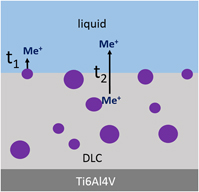Crossref Citations
This article has been cited by the following publications. This list is generated based on data provided by
Crossref.
Stamp, Melanie
Jötten, Anna
Kudella, Patrick
Breyer, Dominik
Strobl, Florian
Geislinger, Thomas
Wixforth, Achim
and
Westerhausen, Christoph
2016.
Exploring the Limits of Cell Adhesion under Shear Stress within Physiological Conditions and beyond on a Chip.
Diagnostics,
Vol. 6,
Issue. 4,
p.
38.
Robertson, Shaun N
Gibson, Des
MacKay, William G
Reid, Stuart
Williams, Craig
and
Birney, Imogen
2017.
Investigation of the antimicrobial properties of modified multilayer diamond-like carbon coatings on 316 stainless steel.
Surface and Coatings Technology,
Vol. 314,
Issue. ,
p.
72.
Buchegger, Sascha
Schuster, Natascha
Stritzker, Bernd
Wixforth, Achim
and
Westerhausen, Christoph
2017.
Multilayer diamond-like amorphous carbon coatings produced by ion irradiation of polymer films.
Surface and Coatings Technology,
Vol. 327,
Issue. ,
p.
42.
Zakarienė, Gintarė
Novoslavskij, Aleksandr
Meškinis, Šarūnas
Vasiliauskas, Andrius
Tamulevičienė, Asta
Tamulevičius, Sigitas
Alter, Thomas
and
Malakauskas, Mindaugas
2018.
Diamond like carbon Ag nanocomposites as a control measure against Campylobacter jejuni and Listeria monocytogenes on food preparation surfaces.
Diamond and Related Materials,
Vol. 81,
Issue. ,
p.
118.
He, Chun
Rogachev, A.V.
Li, Beibei
Yarmolenko, V.A.
Rogachev, A.A.
Tapal'skii, D.V.
Jiang, Xiaohong
Sun, Dongping
and
Yarmolenko, M.A.
2018.
Synthesis and structure of antibacterial coatings formed by electron-beam dispersion of polyvinyl chloride in vacuum.
Surface and Coatings Technology,
Vol. 354,
Issue. ,
p.
38.
Buchegger, Sascha
Kamenac, Andrej
Fuchs, Sven
Herrmann, Rudolf
Houdek, Pia
Gorzelanny, Christian
Obermeier, Andreas
Heller, Stephan
Burgkart, Rainer
Stritzker, Bernd
Wixforth, Achim
and
Westerhausen, Christoph
2019.
Smart antimicrobial efficacy employing pH-sensitive ZnO-doped diamond-like carbon coatings.
Scientific Reports,
Vol. 9,
Issue. 1,
Zhao, Zhiyan
Yu, Xiang
Zhang, Zhiqiang
Shu, Wen
and
Li, Jia
2020.
Attempting AG-Doped Diamond-Like Carbon Film to Improve Seal Performance of Hydraulic Servo-Actuator.
Materials,
Vol. 13,
Issue. 11,
p.
2618.
Brugger, Manuel S.
Baumgartner, Kathrin
Mauritz, Sophie C. F.
Gerlach, Stefan C.
Röder, Florian
Schlosser, Christine
Fluhrer, Regina
Wixforth, Achim
and
Westerhausen, Christoph
2020.
Vibration enhanced cell growth induced by surface acoustic waves as in vitro wound-healing model.
Proceedings of the National Academy of Sciences,
Vol. 117,
Issue. 50,
p.
31603.
Li, Xiaoyun
Wang, Qi
Yu, Yueqi
Fang, Leyi
Wang, Xingwen
Miao, Zhuoyue
Wan, Mimi
Wang, Fenghe
and
Mao, Chun
2020.
In Situ Doping of Metal Nanoparticles into Medical Polymer Membranes and Their Biomedical Application.
ChemistrySelect,
Vol. 5,
Issue. 18,
p.
5451.
Wang, Hao
Wang, Langping
and
Wang, Xiaofeng
2021.
Structure characterization and antibacterial properties of Ag-DLC films fabricated by dual-targets HiPIMS.
Surface and Coatings Technology,
Vol. 410,
Issue. ,
p.
126967.
Zia, Abdul Wasy
Anestopoulos, Ioannis
Panayiotidis, Mihalis I.
Bowen, Leon
and
Birkett, Martin
2023.
Biomechanical characteristics of silver enriched diamond-like carbon coatings for medical applications.
Journal of Alloys and Compounds,
Vol. 958,
Issue. ,
p.
170473.
Song, Zicheng
Liu, Yiming
Liu, Yuwei
Jiang, Xiaohong
Pilipstou, D.G.
and
Rogachev, A.V.
2023.
Improving the protective properties of an artificial joint friction couple by using TiN and DLC films.
Surface and Coatings Technology,
Vol. 472,
Issue. ,
p.
129944.
Wu, Nan
Gao, Hongyu
Wang, Xu
and
Pei, Xibo
2023.
Surface Modification of Titanium Implants by Metal Ions and Nanoparticles for Biomedical Application.
ACS Biomaterials Science & Engineering,
Vol. 9,
Issue. 6,
p.
2970.






